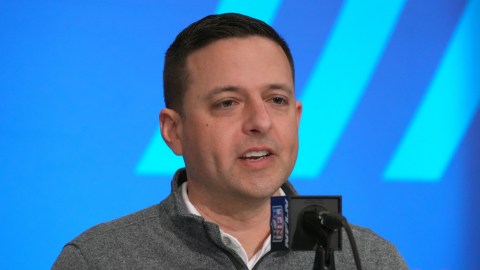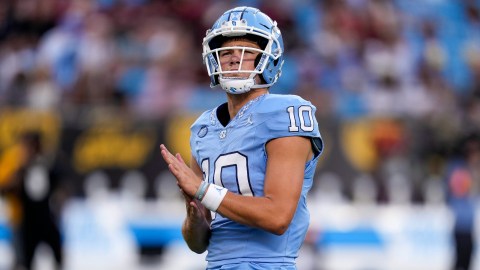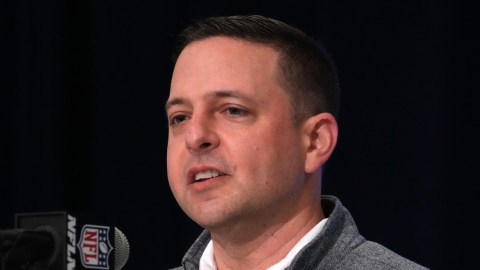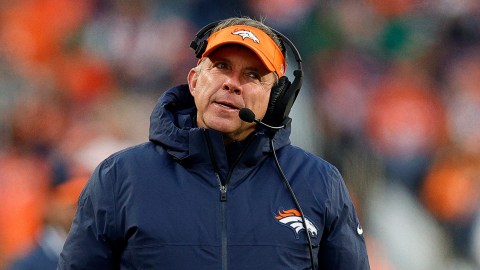 FOXBORO, Mass. — The Patriots have had their fair share of quality tight ends come through New England in the past several years, but they haven’t seemed to jump on the bandwagon of turning basketball players into pass-catchers.
FOXBORO, Mass. — The Patriots have had their fair share of quality tight ends come through New England in the past several years, but they haven’t seemed to jump on the bandwagon of turning basketball players into pass-catchers.
Antonio Gates, Jimmy Graham and Julius Thomas have famously made the transition from playing basketball to tight end. A player the Patriots are preparing to play this week did the same — Jordan Cameron.
Cameron started his collegiate career as a BYU basketball player before taking up football with USC. Belichick seemed to give an obvious answer for why basketball players make good receivers — their hands — but when he dove deeper, saying that basketball players are used to accepting short passes, it began to make more sense.
“I think the biggest thing that I’ve seen with basketball players through the years is their hands,” Belichick said. “Those guys have to have good hands. They obviously handle the ball a lot and it’s on them quickly. They’re cutting and it’s a short pass and a lot of times it comes at good speed or bounce passes and trying to get it around the defender. They have to be able to react to the ball very quickly. It’s a lot different than football, seeing the ball travel however many yards to you. If you’re coming out of a cut, it’s still not like in basketball where the passes are, a lot of times, very short, very tight and you have to reach out and extend and get the ball away from the defender, like you do in football situations. Rebounding the ball, it’s not about — you can’t let it come into your body. You have to go up and aggressively take it. I would just say in general that basketball players, and certainly basketball players that have come into football that I’ve coached or I’ve observed, one pretty common thing is their hands and their ability to handle the ball aggressively, cleanly and it gets on them quickly but it doesn’t seem to affect them like it does other players sometimes where the ball is on them and they can’t quite find it and adjust to it. Those guys seem like they’re used to it. They’ve done it their whole lives and they’re used to it.”
Obviously the ball is shaped differently, but a basketball player can’t let the ball hit him in the chest when he’s bringing in a pass. A basketball player isn’t always expecting the ball to come to them, either. So they have to be quick on their feet while bringing in the ball.
There are some disadvantages to going from basketball to football, though. Belichick said that since the court is so much smaller than a football field, basketball players tend to be quicker but slower than football players. Belichick said legendary basketball coach Bob Knight tried to get him to sign some former players and transition them to the gridiron. It’s not always that easy, though.
“We’ve seen those guys through the years — guys with football backgrounds than end up playing basketball. I’d say I’ve had many conversations with [former Head] Coach Knight about that when he was at Indiana. I would say that the big thing for most basketball players is, in general, they’re quicker than they are fast. When you get out there and time a lot of those guys in the 40-yard dash, they’re slow. They might look fast on a basketball court, but we have such a much bigger field that vertical speed, especially for those positions — there aren’t many linemen playing basketball so you’re talking about skills guys, receivers and DBs, those type of positions, that most of them don’t have the speed that we, at our level, they don’t have the speed to play. They have quickness and a lot of times they have exceptional quickness but when it just comes to straight, flat-out speed, I’d say that’s where a lot of times, in the scouting part of it, the deficiencies come up. You go see a basketball player and say, ‘This guy has great hands. This guy has great quickness. This guy is strong, he’s competitive.’ Then you go out and time him and he runs 4.75-4.8 and you’re like, ‘What are you going to do with him?’ What corner in this league is — they have to be able to run faster than that or if they’re receivers, they have to able to run faster than that. I’ve seen that several times. Like I said, I’ve been in a couple of those situations with Coach Knight at Indiana, like ‘Hey, I want you to take a look at this kid, this guy he’s this, he’s that.’ And he was, but then you go out and put a watch on him and he’s just not fast enough to play at this level. It’s generalities but that’s my general experience with it.”
Patriots receiver Aaron Dobson was highly recruited out of high school to play basketball but chose to play football at Marshall instead. Tight end Matthew Mulligan played basketball at Division III Husson University (then Husson College) before transferring to Maine to play football.
Have a question for Doug Kyed? Send it to him via Twitter at @DougKyedNESN or send it here.
Photo via Facebook/Cleveland Browns from B/R




